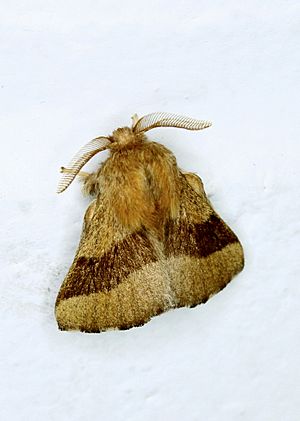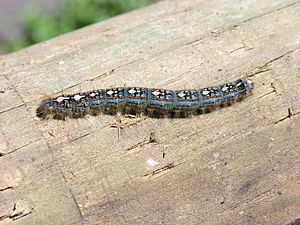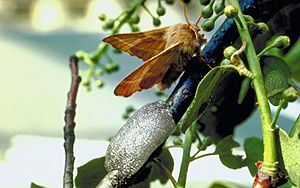Forest tent caterpillar moth facts for kids
Quick facts for kids Forest tent caterpillar moth |
|
|---|---|
 |
|
| Adult | |
 |
|
| Larva | |
| Scientific classification | |
| Synonyms | |
|
The forest tent caterpillar moth (Malacosoma disstria) is a type of moth found all over North America, especially in the eastern parts. Even though it's called a "tent caterpillar," its larvae (the caterpillars) don't actually build big silk tents. Instead, they weave a flat, silky sheet where they rest together when they are molting (shedding their skin).
These caterpillars are very social. They lay down silk trails that have special chemicals called pheromones. They use these trails to travel together in groups. They also gather in groups to rest. As the caterpillars grow bigger, they become less social. By their fifth stage of growth, they often feed and rest on their own.
Adult moths like to lay their eggs on trees like oak, sweetgum, tupelo, aspen, and sugar maple during the summer. Female moths lay up to 300 eggs in a mass. They stick these eggs to twigs and cover them with a special glue called spumaline. This glue protects the eggs from drying out or freezing. The eggs hatch the following spring.
The caterpillars can eat the leaves of many other types of deciduous trees and shrubs. Sometimes, there are huge outbreaks where lots of caterpillars appear. These outbreaks usually happen every ten years or so and last for about two to three years. During these times, trees and shrubs can lose almost all their leaves. But don't worry, most plants grow new leaves without any lasting harm.
Contents
What They Look Like
When they are fully grown (before they turn into moths), the caterpillars are about 2 to 2.5 inches (50 to 64 mm) long. They are usually black, dark brown, or gray. They have wide blue stripes and thin yellow stripes running along their sides. On their back, each body segment has a white spot that is wider towards their head. Their sides are covered with long, fur-like hairs called setae.
The adult moth that comes out after the caterpillar changes (this is called pupation) is yellow or tan. It has a thick, short, furry body. Its wingspan is about 1.5 inches (30 mm). Male and female moths look similar in color, but the female's body is usually larger. This insect is native to North America.
Life Cycle and Habits
The forest tent caterpillar moth is nocturnal, meaning it is active at night. It starts flying soon after it gets dark and rests before the sun comes up. We don't know exactly how far a female moth can fly when she is carrying eggs. However, there's a story about one flying hundreds of kilometers with the help of a very strong wind!
How Caterpillars Grow
The social caterpillars of Malacosoma disstria move around a lot and look for food together. Fifty to two hundred caterpillars can hatch from a single egg mass, and they usually live together for most of their caterpillar stages.
They leave trails of silk with lots of pheromones (chemical signals) on them. These signals tell other caterpillars to move. Being close to other caterpillars also tells them when to rest. This means they use social cues to move around more efficiently. Caterpillars that forage in groups reach the right size for pupation faster. This is important because growing slowly means more risk from predation (being eaten) and running out of food.
However, as caterpillars get older, they become more independent. By their fifth stage, they rarely stay in groups. This change happens because it becomes harder to live in groups as they grow. Things like avoiding predators, staying warm, making silk, and finding food change as they get bigger.
Staying Warm
Forest tent caterpillars are ectotherms. This means they need heat from their environment to warm up their bodies. To do this, they bask (sunbathe) together. Being in a group helps them stay warm. Warming up their bodies is important because it helps them move and digest food faster. This leads to quicker growth.
Fast growth is very important for M. distria caterpillars. They need to grow quickly in the spring, even when it's cool, to get the best food and avoid predators. So, basking in groups is a good way to survive. But as caterpillars grow, they don't need to stay warm as much. Then, other things like competing for food become more important than group living.
Group Behavior
Finding Food
Caterpillars eat at different times. Their feeding trips can happen at any time and are very organized: either the whole group goes to eat, or no one does. Even a few hungry caterpillars can get the whole group to start moving.
However, this organized behavior and their strong loyalty to pheromone trails can sometimes be a problem. It might make caterpillars stick to a poor food source, even if there's a better one nearby. But sometimes, they can be flexible. If some caterpillars are more adventurous or very hungry, they might explore more, which helps the group find better food.
As they get older, finding enough food becomes more important, especially when food is scarce. Being in a group can slow down their growth because they might not get enough to eat. So, as they grow, they become more mobile and independent. This helps them find food better on their own in later stages.
Making Silk
Large silk trails help the caterpillars stick better to the trees they are eating. As caterpillars move in groups, they create thick mats of silk. This gives them a secure grip. Caterpillars that are alone have been seen falling off trees and dying. This might be because they make thin silk strands that don't hold well, or they run out of silk faster. Also, making silk is harder for young caterpillars, so grouping helps them in their early stages. As caterpillars grow, they use less shared silk.
Avoiding Predators
Being in a larger group lowers the risk for each individual caterpillar. This is because of things like collective defense, where they work together to scare off predators. Also, in a big group, the chance of any one caterpillar being eaten is smaller (this is called the dilution effect). Caterpillars in the middle of the group get extra protection.
To avoid being easily seen by predators, caterpillars try to move as little as possible. This makes it harder for predators like insects to find them. But this behavior has a downside: it means caterpillars might not be able to choose the best food sources, as they won't move around to find them.
Caterpillar grouping behavior can change depending on the food source. If the food isn't very good, caterpillar groups might break up. This could make them more vulnerable to predators. As caterpillars get older, their risk of being eaten goes down. So, the benefits of group foraging for avoiding predators also decrease over time. Plus, staying in groups when they are older can increase the risk of spreading diseases among them.
Outbreaks
Forest tent caterpillars become a problem when their numbers explode in the spring. They can completely strip a tree of its leaves. Usually, trees recover from this. They grow new leaves within a month and start making food again through photosynthesis. Most of the time, the trees are not permanently harmed. However, seeing trees without leaves can be a bit messy and unattractive.
In rare cases, if an infestation lasts for three years or more, some trees might die. For example, in Northern Ontario, Canada, in the 1990s, some areas had aspen trees without leaves for over six years in a row. Another outbreak in upstate New York and Vermont started in 2002. By 2005, caterpillars had stripped leaves from 650,000 acres (2600 km²) in New York and 230,000 acres (930 km²) in Vermont.
Outbreaks of forest tent caterpillars tend to happen regularly, about every ten years or so. The exact timing can vary a bit from place to place. These outbreaks usually last for two to four years. Even though these insects live in a very large area, the outbreaks don't always happen at the same time everywhere. They are more synchronized (happen at the same time) in eastern Canada than in western Canada. When outbreaks in different places happen at the same time, it's thought to be because of a process called entrainment, where their natural cycles get in sync with the environment.
Scientists aren't completely sure what causes these regular outbreaks. Many natural things can cause the caterpillar population to drop. These include parasitoids (insects that lay eggs on or in other insects), predators, starvation, diseases, and bad weather. Most infestations end after one or two years because of a mix of these factors. The most common natural enemies that cause the population to decline are flies from the families Tachinidae and Sarcophagidae.



